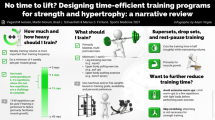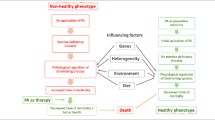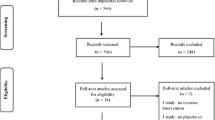Abstract
Although trials have shown that exercise has positive effects on bone mineral density (BMD), the majority of exercise trials have been conducted in older women. The aim of this study was to systematically review trials examining the effect of weight-bearing and resistance-based exercise modalities on the BMD of hip and lumbar spine of middle-aged and older men. Eight electronic databases were searched in August 2012. Randomised controlled or controlled trials that assessed the effect of weight-bearing and resistance-based exercise interventions on BMD measured by dual-energy x-ray absorptiometry, and reported effects in middle-aged and older men were included. Eight trials detailed in nine papers were included. The interventions included walking (n = 2), resistance training (n = 3), walking + resistance training (n = 1), resistance training + impact-loading activities (n = 1) and resistance training + Tai Chi (n = 1). Five of the eight trials achieved a score of less than 50 % on the modified Delphi quality rating scale. Further, there was heterogeneity in the type, intensity, frequency and duration of the exercise regimens. Effects of exercise varied greatly among studies, with six interventions having a positive effect on BMD and two interventions having no significant effect. It appears that resistance training alone or in combination with impact-loading activities are most osteogenic for this population, whereas the walking trials had limited effect on BMD. Therefore, regular resistance training and impact-loading activities should be considered as a strategy to prevent osteoporosis in middle-aged and older men. High quality randomised controlled trials are needed to establish the optimal exercise prescription.

Similar content being viewed by others
References
Khosla S (2012) Pathogenesis of age-related bone loss in humans. J Gerontol Ser A Biol Sci Med Sci
Amin S, Khosla S (2012) Sex- and age-related differences in bone microarchitecture in men relative to women assessed by high-resolution peripheral quantitative computed tomography. J Osteoporos 2012:129760
Warming L, Hassager C, Christiansen C (2002) Changes in bone mineral density with age in men and women: a longitudinal study. Osteoporos Int 13:105–112
Khosla S, Riggs BL (2005) Pathophysiology of age-related bone loss and osteoporosis. Endocrinol Metab Clin N Am 34:1015–1030, xi
Kanis JA (2002) Diagnosis of osteoporosis and assessment of fracture risk. Lancet 359:1929–1936
Marcus R (2002) Post-menopausal osteoporosis. Best Pract Res Clin Obstet Gynaecol 16:309–327
Ryan CS, Petkov VI, Adler RA (2011) Osteoporosis in men: the value of laboratory testing. Osteoporos Int 22:1845–1853
Frost HM (1987) Bone “mass” and the “mechanostat”: a proposal. Anat Rec 219:1–9
Rubin CT, Lanyon LE (1984) Regulation of bone formation by applied dynamic loads. J Bone Joint Surg Am Vol 66:397–402
Kelley GA (1998) Exercise and regional bone mineral density in postmenopausal women: a meta-analytic review of randomized trials. Am J Phys Med Rehabil 77:76–87
Nikander R, Sievanen H, Heinonen A, Daly RM, Uusi-Rasi K, Kannus P (2010) Targeted exercise against osteoporosis: a systematic review and meta-analysis for optimising bone strength throughout life. BMC medicine 8:47
Wolff I, van Croonenborg JJ, Kemper HC, Kostense PJ, Twisk JW (1999) The effect of exercise training programmes on bone mass: a meta-analysis of published controlled trials in pre- and postmenopausal women. Osteoporos Int 9:1–12
Berard A, Bravo G, Gauthier P (1997) Meta-analysis of the effectiveness of physical activity for the prevention of bone loss in postmenopausal women. Osteoporos Int 7:331–337
Kelley GA, Kelley KS (2006) Exercise and bone mineral density at the femoral neck in postmenopausal women: a meta-analysis of controlled clinical trials with individual patient data. Am J Obstet Gynecol 194:760–767
Kelley GA, Kelley KS, Tran ZV (2002) Exercise and lumbar spine bone mineral density in postmenopausal women: a meta-analysis of individual patient data. In The journals of gerontology Series A, Biological sciences and medical sciences M599–604
Borer KT (2005) Physical activity in the prevention and amelioration of osteoporosis in women: interaction of mechanical, hormonal and dietary factors. Sports Med 35:779–830
Schmitt NM, Schmitt J, Doren M (2009) The role of physical activity in the prevention of osteoporosis in postmenopausal women-An update. Maturitas 63:34–38
Gómez-Cabello A, Ara I, González-Agüero A, Casajüs JA, Vicente-Rodríguez G (2012) Effects of training on bone mass in older adults: a systematic review. Sports Med 42:301–325
Lanyon LE (1996) Using functional loading to influence bone mass and architecture: objectives, mechanisms, and relationship with oestrogen of the mechanically adaptive process in bone. Bone 18:37S–43S
Lee KC, Lanyon LE (2004) Mechanical loading influences bone mass through oestrogen receptor alpha. Exerc Sport Sci Rev 32:64–68
Bassey EJ, Rothwell MC, Littlewood JJ, Pye DW (1998) Pre- and postmenopausal women have different bone mineral density responses to the same high-impact exercise. J Bone Miner Res 13(12):1805–1813
Watts NB, Adler RA, Bilezikian JP, Drake MT, Eastell R, Orwoll ES, Finkelstein JS (2012) Osteoporosis in men: an endocrine society clinical practise guideline. J Clin Endocrinol Metab 97:1802–1822
Guadalupe-Grau A, Fuentes T, Guerra B, Calbet JAL (2009) Exercise and bone mass in adults. Sports Med 39:439–468
Kelley GA, Kelley KS, Tran ZV (2000) Exercise and bone mineral density in men: a meta-analysis. J Appl Physiol 88:1730–1736
Kohrt WM, Bloomfield SA, Little KD, Nelson ME, Yingling VR (2004) American college of sports medicine position stand: physical activity and bone health. Med Sci Sports Exerc 36:1985–1996
Verhagen AP, de Vet HC, de Bie RA, Kessels AG, Boers M, Bouter LM, Knipschild PG (1998) The Delphi list: a criteria list for quality assessment of randomized clinical trials for conducting systematic reviews developed by Delphi consensus. J Clin Epidemiol 51:1235–1241
Verhagen AP, de Vet HC, de Bie RA, Boers M, van den Brandt PA (2001) The art of quality assessment of RCTs included in systematic reviews. J Clin Epidemiol 54:651–654
Woo J, Hong A, Lau E, Lynn H (2007) A randomised controlled trial of Tai Chi and resistance exercise on bone health, muscle strength and balance in community-living elderly people. Age Ageing 262–268
Whiteford J, Ackland TR, Dhaliwal SS, James AP, Woodhouse JJ, Price R, Prince RL, Kerr DA (2010) Effects of a 1-year randomized controlled trial of resistance training on lower limb bone and muscle structure and function in older men. Osteoporos Int 21(9):1529–1536
Kukuljan S, Nowson CA, Bass SL, Sanders K, Nicholson GC, Seibel MJ, Salmon J, Daly RM (2009) Effects of a multi-component exercise programme and calcium-vitamin-D3-fortified milk on bone mineral density in older men: a randomised controlled trial. Osteoporos Int 20(7):1241–1251
Kukuljan S, Nowson CA, Sanders KM, Nicholson GC, Seibel MJ, Salmon J, Daly RM (2011) Independent and combined effects of calcium-vitamin d3 and exercise on bone structure and strength in older men: an 18-month factorial design randomized controlled trial. J Clin Endocrinol Metab 96(4):955–963
Ryan AS, Treuth MS, Rubin MA, Miller JP, Nicklas BJ, Landis DM, Pratley RE, Libanati CR, Gundberg CM, Hurley BF (1994) Effects of strength training on bone mineral density: hormonal and bone turnover relationships. J Appl Physiol 1678–1684
Paillard T, Lafont C, Costes-Salon MC, Rivière D, Dupui P (2004) Effects of brisk walking on static and dynamic balance, locomotion, body composition and aerobic capacity in ageing healthy active men. Int J Sports Med 25(7):539–546
Huuskonen J, Vaisanen SB, Kroger H, Jurvelin JS, Alhava E, Rauramaa R (2001) Regular physical exercise and bone mineral density: a four-year controlled randomized trial in middle-aged men. The DNASCO study. Osteoporos Int 12(5):349–355
Menkes A, Mazel S, Redmond RA, Koffler K, Libanati CR, Gundberg CM, Zizic TM, Hagberg JM, Pratley RE, Hurley BF (1993) Strength training increases regional bone mineral density and bone remodeling in middle-aged and older men. J Appl Physiol 74:2478–2484
Braith RW, Mills RM, Welsch MA, Keller JW, Pollock ML (1996) Resistance exercise training restores bone mineral density in heart transplant recipients. J Am Coll Cardiol 28(6):1471–1477
Turner CH, Robling AG (2005) Mechanisms by which exercise improves bone strength. J Bone Miner Metab 23(Suppl):16–22
Turner CH (1998) Three rules for bone adaptation to mechanical stimuli. Bone 23:399–407
Bailey CA, Brooke-Wavell K (2010) Optimum frequency of exercise for bone health: randomised controlled trial of a high- impact unilateral intervention. Bone 46(4):1043–1049
Martyn-St. James M, Carroll S (2006) High-intensity resistance training and postmenopausal bone loss: a meta-analysis. Osteoporos Int 17:1225–1240
Martyn-St James M, Carroll S (2010) Effects of different impact exercise modalities on bone mineral density in premenopausal women: a meta-analysis. J Bone Miner Metab 28:251–267
Specker B, Vukovich M (2007) Evidence for an interaction between exercise and nutrition for improved bone health during growth. Med Sport Sci 51:50–63
Howe TE, Shea B, Dawson LJ, Downie F, Murray A, Ross C, Harbour RT, Caldwell LM, Creed G (2011) Exercise for preventing and treating osteoporosis in postmenopausal women. Cochrane database of systematic reviews (Online) CD000333 doi:10.1002/14651858.CD000333.pub2
Martyn-St JM, Carroll S (2008) Meta-analysis of walking for preservation of bone mineral density in postmenopausal women. Bone 43:521–531
Martyn-St JM, Carroll S (2009) A meta-analysis of impact exercise on postmenopausal bone loss: the case for mixed loading exercise programmes. Br J Sports Med 43:898–908
Hunter GR, McCarthy JP, Bamman MM (2004) Effects of resistance training on older adults. Sports Med 34:329–348
Kannus P, Sievanen H, Palvanen M, Jarvinen T, Parkkari J (2005) Prevention of falls and consequent injuries in elderly people. Lancet 366(20):1885–1893
Galvao DA, Nosaka K, Taaffe DR, Spry N, Kristjanson LJ, McGuigan MR, Suzuki K, Yamaya K, Newton RU (2006) Resistance training and reduction of treatment side effects in prostate cancer patients. Med Sci Sports Exerc 38:2045–2052
Winters-Stone KM, Dobek J, Nail LM, Bennett JA, Leo MC, Torgrimson-Ojerio B, Luoh SW, Schwartz A (2012) Impact + resistance training improves bone health and body composition in prematurely menopausal breast cancer survivors: a randomized controlled trial. Osteoporosis international: a journal established as result of cooperation between the European Foundation for Osteoporosis and the National Osteoporosis Foundation of the USA
Saarto T, Sievanen H, Kellokumpu-Lehtinen P et al (2012) Effect of supervised and home exercise training on bone mineral density among breast cancer patients. A 12-month randomised controlled trial. Osteoporos Int 23(5):1601–1612
Bolotin HH, Sievanen H (2001) Inaccuracies inherent in dual-energy X-ray absorptiometry in vivo bone mineral density can seriously mislead diagnostic/prognostic interpretations of patient-specific bone fragility. J Bone Miner Res: Off J Am Soc Bone Miner Res 16:799–805
Conflicts of interest
None.
Author information
Authors and Affiliations
Corresponding author
Rights and permissions
About this article
Cite this article
Bolam, K.A., van Uffelen, J.G.Z. & Taaffe, D.R. The effect of physical exercise on bone density in middle-aged and older men: A systematic review. Osteoporos Int 24, 2749–2762 (2013). https://doi.org/10.1007/s00198-013-2346-1
Received:
Accepted:
Published:
Issue Date:
DOI: https://doi.org/10.1007/s00198-013-2346-1




